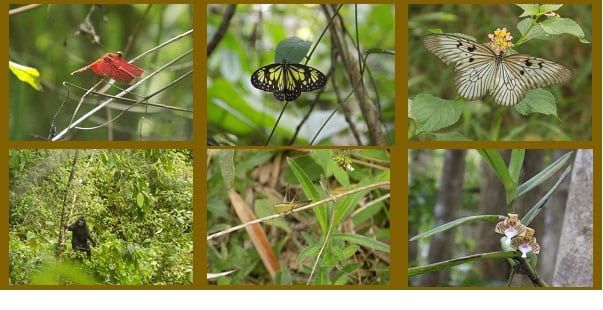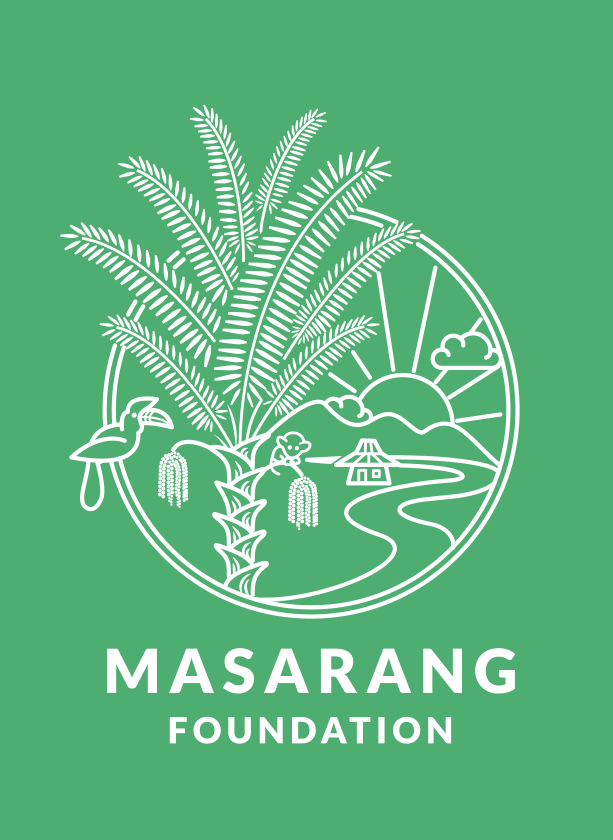The Pulisan reforestation project
Pulisan is the name of a small watershed in the southern part of Tomohon, located on the top of a steep mountain ridge. The name is an expression in the Tombulu language that means something like: “place where water disappears”. And that is exactly what happens here! There is no visible river flowing out of this almost 70-hectare large watershed and the water flows towards the middle of this long-stretched water catchment area where it mysteriously disappears into the soil. Until now we cannot say for sure where the water goes but there is a big spring just north of the area inside a deep forested canyon at less than a kilometre away and it would be an interesting experiment to release some Potassium Permanganate, a powerful and non-poisonous colorant, in the area and check the surrounding springs for signs of the tell-tale purple colour!

Supported by the Gibbon Foundation, the Masarang Foundation started buying land in this watershed with the original aim of setting up a waste processing facility. The goal was to collect and process all the waste of Tomohon, thereby promoting cleanliness, health, jobs and income. We already bought second hand waste collection trucks from Japan and had advanced discussions with a company to set up the recycling and composting parts and the construction of the sanitary land fill. Unfortunately, a corrupt Tomohon mayor blocked the project since there was no money in it for him or other city officials from our Masarang Foundation. That mayor was later convicted of extensive fraud and is still in jail at the time that I write this blog in July 2017.
The area could have provided a waste solution for more than 100 years for Tomohon and vast surroundings, but in the mean time we, Masarang, could also use the area as an experimental reforestation project, which we did. That has now become the most important focus of the Pulisan reforestation project. The area was almost completely devoid of trees when we started buying the pieces of agricultural land. But soon our trees started dominating the land and wildlife is now coming back as well. I will write more on the set up of the many reforestation experiments in a follow up blog with the research results.
The project was started by me and Harry Kaunang, a forester from Tomohon and now the Matani III village head in Tomohon. When Harry became the lurah or village head, Sonny Ering took over the management of the conservation division of the Masarang Foundation. And recently Sonny sat with me at the terrace of my rental house in Tomohon to give me an update that I would like to share with you here.

It was 06.00 on a Sunday morning when I heard the small motorbike with the giant figure on it approaching my house. Sonny is an incredibly muscular guy with an enormous chest and a weight of 107 kilograms, which is more than double that of most farmers in Tomohon. His physical size is only matched by his big smile. This combination makes him very suited to be head of our rangers and responsible for protecting the lands of Masarang! After we sat down at my terrace while the morning damps gradually opened up with sun rays, revealing the contours of the big Lokon Volcano that is right in front of my rental abode.
After the usual introduction of the practical issues Sonny faces with staff and administration and need for more funds he got to my favourite part, trees and animals. Sonny spends a lot of his time patrolling our forests, observing trees, wildlife and passers by, and is a very reliable source of information. And he makes good use of the camera Masarang provided him to take pictures of the wildlife in Pulisan.

Now twelve years after we bought and planted the very first parcel of land, the area is 90% reforested and the first sugar palms start now producing the sugary juice that our Masarang Sugar Factory processes into Arenga palm sugar, in the process creating many new jobs. Sonny is supervising the first four palm tappers in our reforestation area and they will also be very useful as additional eyes and ears to protect the wildlife in Pulisan. There is a lot of traditional hunting going on in North Sulawesi, where bushmeat continues to be sold illegally on the local market. And the wildlife in our reforestation area attracts the interest of the hunters. There are still some pieces of land that Masarang has not bought yet that provide people with a reason to enter the area and the construction of an asphalt road along the south border two years ago has made access even easier and Sonny’s job of protecting the wild animals that have made the new forest their home more difficult.
Sonny starts showing me pictures and telling me about the animals he has observed in our Pulisan forest. Pigs are abundant there now and recently he has also spotted two deer and they are the most important reason for poachers trying to hunt there. The number of birds as well as the number of species of birds has also increased dramatically in the Pulisan forest. But the most remarkable new inhabitants of the area are the endemic crested macaques. There are two groups of them that now regularly pass through our forest and they often walk on the ground between the trees, one of the groups comprising 40 monkeys and the second one some 30. They like to eat the shoots of the “nanas hutan” or forest pineapple, which actually is a species of Pandanus.

Sonny’s house is in the village of Pinaras and the house closest to the new forest. From his house one can see across the small river that becomes the Pinaras waterfall and at night his dogs wake him when people come hunting with their own dogs. From his wooden house he can see the slight reflections of flashlights of the rat hunters going in between the trees looking for the white tailed rats that are a traditional delicacy in North Sulawesi. But they also like to hunt other animals like the couscous when they come across them by accident. Even the tiniest reflection is enough to get Sonny into action for another nightly inspection to tell the intruders not to hunt in our foundations forest.

Already once Sonny found a dead macaque that had eaten a poisoned banana. Killed by the readily available rat poison that also is hidden in pieces of meat thrown over fences of people to kill their dogs to be sold as dog meat on the infamous Tomohon market. Thanks to our Masarang education program the young generation in Tomohon hardly eats bushmeat and dog meat anymore but many of the older generation are fierce in their defence of their traditions and do not take easy to people telling them about animal welfare as reason for abandoning these habits! Law enforcement officers have known to be beaten up and chased out of the Tomohon market in the past. The only thing that sometimes seems to work for a while is when we had campaigns about the danger of diseases from bushmeat.
Hunters are quite creative in their ways to hunt animals. They study their movements and adjust their hunting techniques all the time, making it difficult for Sonny and his rangers to interfere. He has found fish hooks hung from nails in fruit trees in which the macaques can get caught. Snares are often difficult to spot compared to the bamboo trap cages with bait. Sometimes people hang up very fine nets between trees to catch the bats which again are a popular bushmeat in many places in North Sulawesi and that often are brought from more than one thousand kilometers away to be sold here.
Sonny explains how he was able to take so many pictures of animals. He proudly shows me film clips of the macaques and explains that he often lays under a camouflage sack on the ground for hours to see the macaques approaching. Imagine, the moist mud, the numerous ants, the nasty mosquitoes and this sweating giant lying like a guerrilla fighter underneath a cloth carefully aiming his camera without scaring the animals. Hunters passing by have been scared by his sudden appearance out of nothing! Sonny tells me that many people don’t like him but that he is dedicated to protecting the forest and its animals.
One of the projects of Masarang is to try to fence off this new experimental forest to protect it permanently from hunters. Also the five hectares of land in between our 65 hectares of Masarang land still owned by local people need to be bought but the prices for the land have risen very significantly since the construction of the asphalt road, making it more difficult for our foundation. And if we ask for the land the prices become even more astronomical so we must wait until the people themselves come to offer their land for sale.

Sonny also comes with a proposal to plant a newly acquired piece of land in Pulisan. He needs more polybags for seedlings, planting tools, etc. He proposes that every two weeks the Masarang office staff comes along to plant some trees so that even the people managing the administration feel connected to our new forests. Not bad! Then we only need funds for transport and enhance the team spirit. He also suggests to buy some cows to help us collect the palm juice and palm fibres from the area which can support the maintenance of the forest. And the people caring for the cows, feeding them with fodder from the many edible tree shoots that need pruning, will have jobs while helping to protect the area. It is great to see Sonny coming up with real solutions. I like to call him Mr. Masarang!
Sonny sometimes is sent to other locations in Indonesia to train people in setting up nurseries for sugar palms and reforestation techniques. I ask him what his family feels about him spending much more than regular working hours away from home, both when he is on a special training job or when he wanders off at night to protect the trees and animals. He tells me how he sometimes likes to bring his wife with him into the forest. Then they sit together on a rock or fallen tree and he tells her about all the wonderful things they see in the forest. Then they are happy together and grateful for God’s beautiful creation. And that is why his wife understands why her husband Sonny is doing what he does and fully supports him and our Masarang Foundation. Here are a few more pictures of our guardian of the Pulisan Forest that show Sonny’s broad interest in nature. Many thanks to all our loyal Masarang supporters for giving us the chance to do this important work and give people like Sonny a chance to spread our environmental message.

Willie Smits, 14-7-2017
